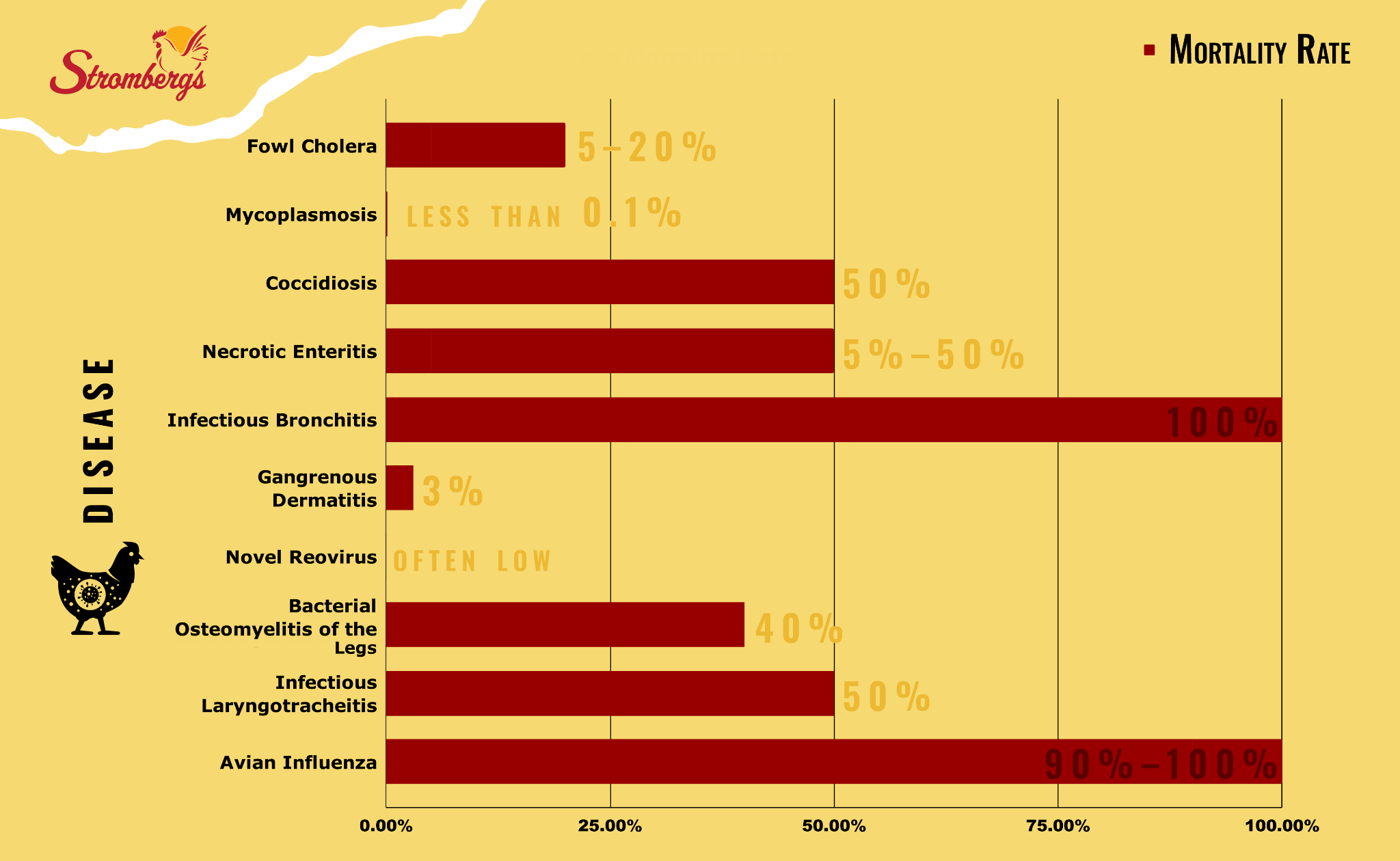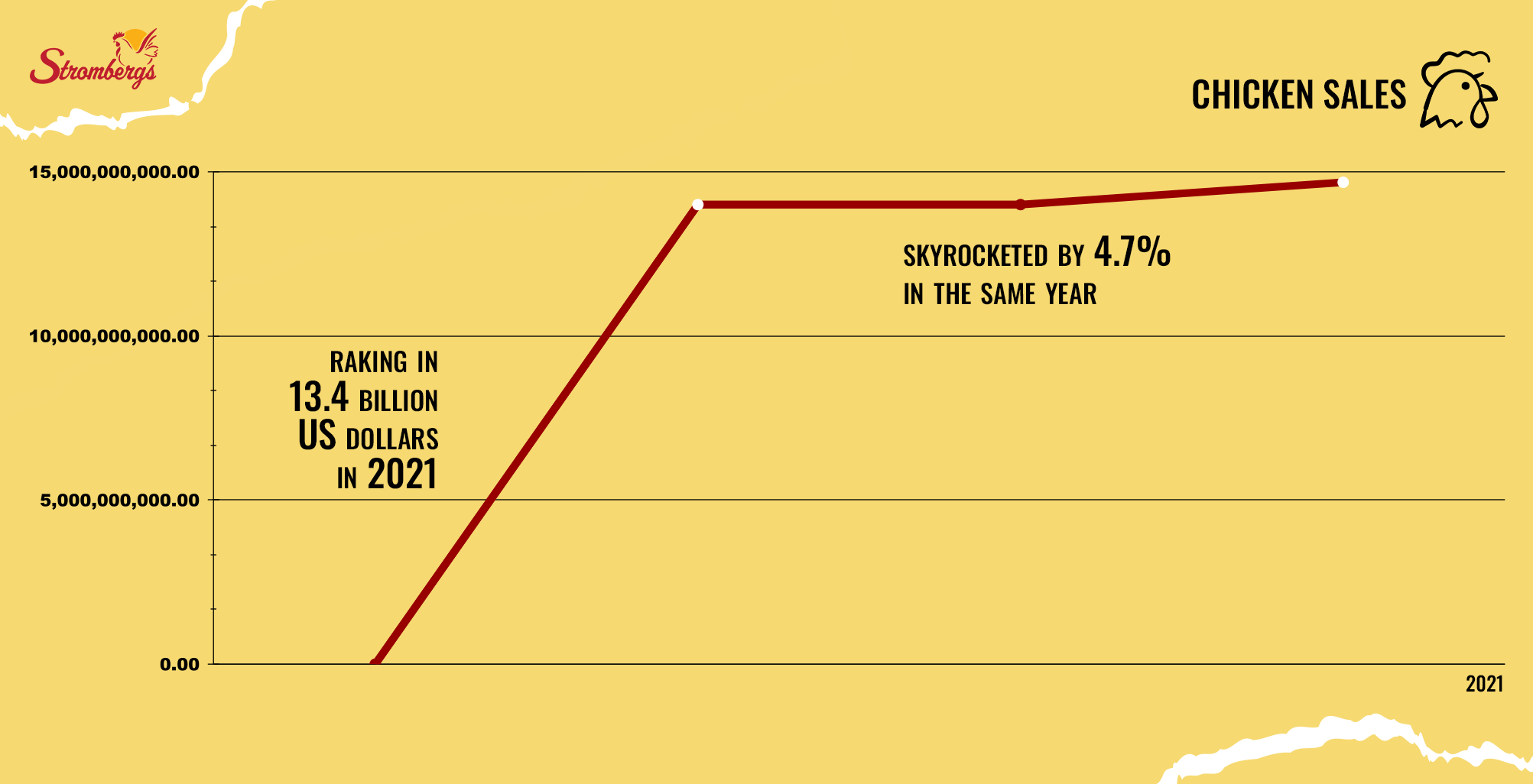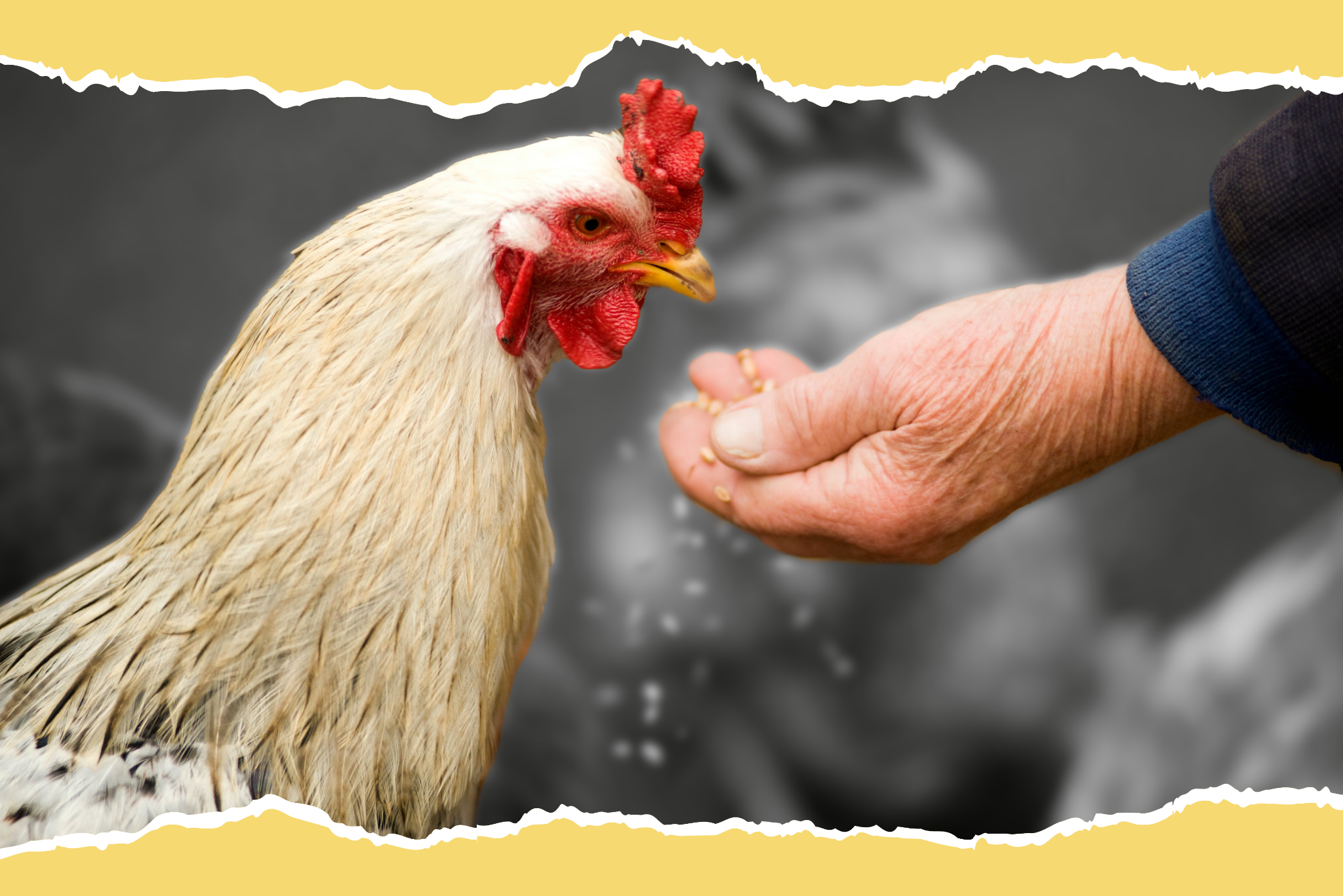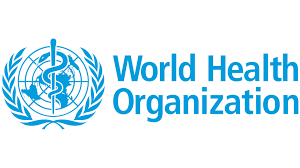Sources

Americans love their chicken. According to statistics, chicken was the second-most important fresh meat category, with sales raking in 13.4 billion US dollars in 2021. Chicken sales skyrocketed by 4.7% in the same year. With this consumption rate, the future is bright for the poultry industry.
However, several challenges plague poultry and broiler farms, with disease control front and center. For farm owners and investors, it’s essential to learn how to overcome this obstacle to ensure a smooth-flowing business. In this article, you’ll learn more about the common hurdles poultry farms face, their causes, and proven tips on preventing such incidents.
Table of Contents
Common Challenges That Hinder Today’s Poultry Farms
Animal welfare, poultry environment, feed formulation, and additive restrictions are common challenges the poultry industry faces. However, food contamination by pathogens remains the top concern of consumers.
As demand for animal products increases, so does the public’s growing concern for food safety. Because of this, poultry farms and governments are expected to uphold transparency and a commitment to safer food, strictly controlling every step of the food supply chain to secure the health of the flock.
Common Poultry Diseases and Their Causes

Outbreaks are one of the most expensive animal health disasters in the US. In fact, the federal government spent almost $1 billion to handle the avian influenza or bird flu outbreak in 2015. The industry spent roughly $3 billion to compensate farmers who suffered from lost income and additional costs without birds on their farms.
And it isn’t just bird flu that threatens the health of chickens and poultry farms. Without proper disease control and prevention, the following conditions can easily spread across commercial farms.
| Disease | Prevalence | Mortality rate | Cause | How it spreads | Who are affected | Common signs |
|---|---|---|---|---|---|---|
| Fowl Cholera | Most common to older chickens | Mortality rate of 5–20% | Pasteurella Multocida | Via ingestion, mechanically by arthropod vectors or by inhalation. | Most common found in older chickens | Loss of appetite, diarrhea with a greenish tinge, ruffled feathers, swollen purple wattle, swollen comb, swollen joints, lameness, oral, nasal and ocular discharge and sudden death. |
| Mycoplasmosis | most common upper respiratory infection of backyard chicken flocks | less than 0.1% | Small droplets that spread through the air after a person infected with mycoplasma pneumoniae sneezes or coughs | by coughing or sneezing | laying hens | fever, cough, bronchitis, sore throat, headache and tiredness. |
| Coccidiosis | Highest-ranking broiler disease in Brazil from 2017 to 2020 | Mortality rate of 50% | Protozoan parasites of the genus Eimeria | Transmitted by mechanical carriers like wild birds and insects | Usually affects young animals | Decreased growth rate, visibly sick birds, high mortality, and severe diarrhea |
| Necrotic enteritis | Affects around 40% of commercial broiler flocks in the US | Mortality rate of 5%–50% | Over proliferation of Clostridium perfringens | Fecal-oral transmission | 2- to 5-week-old broiler chickens, 7- to 12-week-old turkeys | Diarrhea, depression, dehydration, ruffled feathers, decrease in feed consumption |
| Infectious bronchitis | Common across different regions globally | Morbidity rate is typically 100%, especially for unvaccinated flocks | Infectious bronchitis virus (IBV) strains emerging from layer, broiler, or breeder | Aerosol, contact with contaminated equipment, or ingestion of contaminated water or feed | Occurs at any age | Respiratory distress manifested through coughing, sneezing, and rales; conjunctivitis; nasal discharge; and wrinkled eggs |
| Gangrenous dermatitis | Considered one of the top three most prioritized poultry diseases in the US | Daily mortality ranging from a few birds to 3% | Caused by Clostridium septicum, C perfingens type A, and Staphyloccocus auereus; may be caused by predisposing diseases or poor environmental conditions | Orofecal transmission | Generally observed in close-to-market age or less than 35 days old among broiler chickens | Infected birds show decay in the skin and subcutaneous tissue, particularly in the abdomen, breast, thigh, or wing |
| Novel reovirus | Common among domestic poultry and other bird species | Mortality is often low but many birds can be infected | Avian reovirus (ARV) in the genus Orthoreovirus | Oral-fecal route or from breeders to progeny | Affects mostly young birds (3–6 weeks) | Viral arthritis characterized by swelling of the hock joints, lesions found in the gastrocnemius tendons |
| Bacterial osteomyelitis of the legs | Common cause of lameness, affecting 1.5% of broilers in Europe and the US | 40% of mortality is from culling due to lameness | Usually caused by Staphylococcus aureus and E. coli, especially when the chicken has an existing injury or wound like bumblefoot | Breeder to chicks, contaminated eggshells, or hatchery sources | Often affects broilers more than 22 days old | Lameness or green discoloration of the liver |
| Infectious laryngotracheitis | Reported in most areas of the US where poultry production is high | Mortality may reach 50% in adults | Caused by Gallid alpha herpesvirus type 1 (GaHV-1), commonly referred to as infectious laryngotracheitis virus (ILTV) | Easily transmitted through contaminated litter, transportation of infected birds, and weak biosecurity | Primarily affects chickens, pheasants, turkeys, and peafowl | Severe dyspnea, conjunctivitis, rales, and coughing |
| Avian influenza | Affecting around 58 million commercial poultry, wild aquatic birds, and backyard flocks in the US to date | Mortality of up to 90%–100% in chickens | Avian influenza Type A viruses | Transmitted through saliva, feces, nasal secretions, or contact with contaminated surfaces | Occurs naturally among wild aquatic birds but can infect domestic poultry | Gasping, extreme diarrhea, swelling around the eyes, head, and neck, or purple discoloration in the head and legs, followed by rapid death |
How to Effectively Prevent Diseases in Chicken Farms
Poultry farming can be a rewarding and lucrative business, but it comes with its unique challenges regarding health and safety. Proper biosecurity measures, equipment maintenance, and safe handling practices are just a few factors that can affect the health and wellbeing of animals and workers.
The following tips will help poultry farmers and hobbyists minimize the risk of disease outbreaks and ensure healthy and safe operations.

Practice Good Biosecurity
According to a report by the United States Department of Agriculture (USDA), poor biosecurity practices are one of the leading causes of disease outbreaks in poultry flocks. With this, it is essential to take proper measures to prevent the spread of disease from outside sources to one’s farm. Some key biosecurity practices include the following:
- Limit visitor access. Only essential personnel should have access inside the farm, and they must follow strict sanitation protocols.
- Keep farms clean at all times. Regularly cleaning and disinfecting poultry facilities, equipment, and vehicles help prevent the spread of diseases.
- Prevent contamination with proper sectioning. Keeping wild birds, rodents, and other potential disease carriers away from the farm is a crucial step to prevent cross-contamination between different areas of the facility.
- Use appropriate protective equipment. Farm owners and operators should wear protective clothing, gloves, and boots to prevent disease transmission.
Implementing these practices helps reduce the possibility of disease outbreaks in farms, safeguarding the health of the poultry and business.
Manage Waste Efficiently
According to the University of Kentucky College of Agriculture, effective waste management is essential for maintaining a clean and healthy environment for poultry. Poultry waste, including manure and bedding, can harbor harmful pathogens and parasites, causing diseases and infections in birds and humans. Farmers should use appropriate cleaning and disinfection techniques, such as regularly removing, disposing, and composting waste.
Proper Disinfection and Sanitation Practices
Keeping a clean and hygienic environment is essential for maintaining poultry farm health and safety. Regularly disinfecting and cleaning the farm, water and feed equipment, and egg collection areas are necessary to ensure this. A good practice is implementing sanitary measures before the arrival of new birds and regularly after that.
Farm owners must use disinfectants according to the manufacturer’s instructions, thoroughly cleaning all equipment and surfaces with soap and water before disinfection. Another vital tip is to allow proper ventilation during disinfection and to follow safety protocols when handling chemicals.
Ensure Proper Nutrition for Flocks
Proper nutrition and living conditions for healthy chickens is essential for maintaining the health and productivity of poultry farms. According to the University of Kentucky College of Agriculture, improper nutrition can lead to poor growth, reduced egg production, and weakened immune systems, making birds more susceptible to diseases.
Farmers should provide a balanced diet, ensure clean and fresh feeds, and monitor feed consumption to ensure the birds receive adequate nutrition.
Allow for Adequate Ventilation
Good ventilation is essential for maintaining good air quality and preventing respiratory diseases in poultry farms. Proper ventilation helps remove excess heat, moisture, and dust from the poultry house, providing a comfortable environment for the birds.
According to a study published in the Journal of Applied Poultry Research, poor ventilation can lead to high levels of ammonia, carbon dioxide, and other harmful gasses, which can cause respiratory problems and reduce bird productivity. Farmers should maintain proper ventilation by providing adequate air exchange rates, maintaining the right temperature and humidity levels, and regularly cleaning and maintaining ventilation systems.
Implement Proper Handling and Transporting Techniques
Proper handling helps prevent injury and stress in chickens and protects workers from potential hazards. Farm owners should train their workers to handle birds gently and safely, including proper lifting and carrying techniques. Another effective tip is establishing a protocol for handling sick or injured birds to prevent further harm.
Transporting the flock also requires proper methods to minimize untoward accidents. Transport cages and vehicles should be handled gently and thoroughly cleaned and disinfected. It’s also important to follow appropriate biosecurity protocols to prevent the spread of disease.
Follow Vaccination Protocols for Poultry
Vaccines effectively prevent or minimize the adverse effects brought by chicken diseases. Furthermore, they also help keep consumers safe from ingesting infected poultry products. Some vaccines the USDA recommends for commercial poultry are usually for Marek’s disease, infectious bronchitis, Newcastle disease, and infectious laryngotracheitis. Poultry farm owners are advised to follow the updated vaccination programs for different kinds of poultry.
Stay Educated and Up to Date
Staying on top of the latest practices and regulations for poultry farming is essential for maintaining a healthy and safe environment for the flock. Poultry farmers are expected to attend training sessions, conferences, and workshops to learn about the latest advancements in poultry disease management. Keeping up with industry news and research can also help farmers make informed decisions and implement the best practices on their farms.
Maintaining a healthy and safe environment is crucial for the success of any poultry farm. By following these tips and best practices, poultry farmers can ensure the health and wellbeing of their birds, prevent the spread of disease, and minimize the risk of injury or accidents. Farmers can continue to improve their practices and maintain a thriving and profitable business by staying informed of the most recent developments in the industry.
Poultry Health and Safety Above All: Common Mistakes to Avoid

Poultry farming is a rewarding and fulfilling endeavor, but it also comes with potential health and safety risks. Regrettably, many poultry owners make mistakes that endanger the well-being of their flocks and their own safety, which can cause disease outbreaks, accidents, and other issues.
Neglecting Biosecurity Measures
Biosecurity is a set of standards designed to prevent the introduction and spread of infectious diseases in a population of animals or plants. Neglecting biosecurity measures can spread diseases such as avian influenza, which can cause severe illness and even death in birds and humans.
Improper Feeding and Watering Methods
Inadequate feeding can lead to nutritional deficiencies in birds, resulting in poor growth, decreased egg production, and other health problems. Improper watering methods also increase your flock’s risk of infections and catching diseases. For example, salmonella is transmitted through contaminated water sources.
Inadequate Housing and Unsanitary Conditions
According to the USDA, poor housing conditions can spread disease and increase mortality rates in poultry flocks. Additionally, poor sanitation in chicken farming can cause the growth of dangerous bacteria and other pathogens, endangering the health of humans and birds.
Unsafe Poultry Handling and Processing
The Centers for Disease Control and Prevention (CDC) states that improper handling and processing of poultry products can spread harmful bacteria, such as campylobacter and salmonella, which can cause severe illness in humans.
The Takeaway
Poultry products are a must-have in most diets worldwide, which is why the poultry industry continues to bring in lucrative business. But to succeed, poultry farm owners should navigate the ongoing challenges that this business entails. One vital aspect to take into major consideration is disease control and prevention.
Poultry farms are expected to uphold the best sanitation, health, and biosecurity measures to keep their business going. Otherwise, they will be looking at additional costs due to outbreaks and even consumer endangerment. But with proper knowledge and guidance, farm owners are expected to see a bright future ahead.
References:
- Avian Reovirus Infections. (n.d.). https://www.thepoultrysite.com/articles/avian-reovirus-infections
- Bacterial Chondronecrosis with Osteomyelitis - Lameness. (n.d.). @Anh. https://www.dsm.com/anh/challenges/supporting-animal-health/bco-lameness.html
- Chicken and Food Poisoning. (2022, October 31). Centers for Disease Control and Prevention. https://www.cdc.gov/foodsafety/chicken.html
- Choi, Y., Kim, S. F., Shang, K., Park, J., Zhang, J., Jang, H., Wei, B., Cha, S., & Kang, M. H. (2022). Avian Reoviruses From Wild Birds Exhibit Pathogenicity to Specific Pathogen Free Chickens by Footpad Route. Frontiers in Veterinary Science, 9. https://doi.org/10.3389/fvets.2022.844903
- Commercial Operations - Waste Management | Animal & Food Sciences. (n.d.). https://afs.ca.uky.edu/poultry/commercial-operations-waste-management
- Ennaji, Y., Khataby, K., & Ennaji, M. M. (2019). Infectious Bronchitis Virus in Poultry: Molecular Epidemiology and Factors Leading to the Emergence and Reemergence of Novel Strains of Infectious Bronchitis Virus. Elsevier EBooks, 31–44. https://doi.org/10.1016/b978-0-12-814966-9.00003-2
- Eskin, S. (2020, September 24). Vaccines for Poultry Are Crucial for Preventing Salmonella Contamination. The Pew Charitable Trusts. https://www.pewtrusts.org/en/research-and-analysis/articles/2020/09/24/vaccines-for-poultry-are-crucial-for-preventing-salmonella-contamination
- Garcia, M. (2023, February 23). Infectious Laryngotracheitis in Poultry. MSD Veterinary Manual. https://www.msdvetmanual.com/poultry/infectious-laryngotracheitis/infectious-laryngotracheitis-in-poultry
- Gornatti-Churria, C. D., Crispo, M., Shivaprasad, H. L., & Uzal, F. A. (2018). Gangrenous dermatitis in chickens and turkeys. Journal of Veterinary Diagnostic Investigation, 30(2), 188–196. https://doi.org/10.1177/1040638717742435
- H5 Viruses in the United States | Avian Influenza (Flu). (n.d.). https://www.cdc.gov/flu/avianflu/h5/index.htm
- Journal of Applied Poultry Research | ScienceDirect.com by Elsevier. (n.d.). https://www.sciencedirect.com/journal/journal-of-applied-poultry-research
- Llc, A. (n.d.). Bumblefoot in Chickens. PoultryDVM. http://www.poultrydvm.com/condition/bumblefoot
- Necrotic enteritis. (n.d.). @Anh. https://www.dsm.com/anh/challenges/supporting-animal-health/necrotic-enteritis.html
- Nutrition | Animal & Food Sciences. (n.d.). https://afs.ca.uky.edu/poultry/nutrition
- Oviedo-Rondón, E. & North Carolina State University. (n.d.). Optimizing the health of broilers. Burleigh Dodds Science Publishing Limited, 2022. https://bdspublishing.com/_webedit/uploaded-files/All%20Files/Open%20Access/9781801464222.pdf
- Shahbandeh, M. (2022, July 12). U.S. retail sales of fresh meat 2021, by type. Statista. https://www.statista.com/statistics/256045/us-retail-sales-of-fresh-meat-by-type/
- Shahbandeh, M. (2023, January 23). Sales growth of fresh meat in the U.S. 2022, by type. Statista. https://www.statista.com/statistics/322090/sales-growth-of-fresh-meat-in-the-us-by-product/
- Stewart-Brown, B. (2023, February 23). Vaccination Programs in Poultry. MSD Veterinary Manual. https://www.msdvetmanual.com/poultry/nutrition-and-management-poultry/vaccination-programs-in-poultry
- Reporting for Bird Detections across the United States. (2023, February 22). Centers for Disease Control and Prevention. https://www.cdc.gov/flu/avianflu/data-map-commercial.html
- Role of Intestinal Pathology and Clostridial Species in Clostridial Dermatitis on U.S. TurkeyGrower Farms. (2012). Veterinary Services Centers for Epidemiology and Animal Health. https://www.aphis.usda.gov/animal_health/nahms/poultry/downloads/poultry10/Poultry10_is_IntPath.pdf
- USDA APHIS | Defend the Flock - Biosecurity 101. (n.d.). https://www.aphis.usda.gov/aphis/ourfocus/animalhealth/animal-disease-information/avian/defend-the-flock-program/dtf-biosecurity




